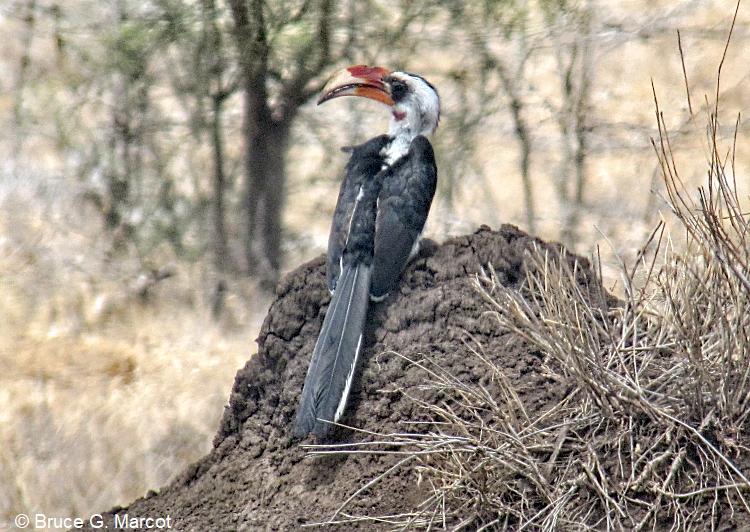|
Explanation: This
is actually a tale of two life forms. We
are in northern Tanzania, in Sinya Wildlife Management Area, just a couple of
stone's throws from Mount Kilimanjaro. And here sits a lovely Von
der Decken's Hornbill, a not uncommon denizen of arid east tropical
Africa. But it
is what it is sitting on that is part of the story: a termite
mound. Termite
mounds may superficially appear as sterile lumps of mud and dirt in an
otherwise vegetated environment, but they, and their invertebrate builders,
play many key ecological functions in their ecosystem. For
one, termite mounds provide important perch sites for a wide variety of birds,
mammals, and even reptiles, serving as a watch-post that garners greater
visibility for spotting potential predators. Further, some species
may excavate cavities or hollows in termite mounds as nesting,
breeding, resting, and hiding cover. Some
termite mounds also serve as "nurse
mounds" supporting growth of vegetation and nutrients for
plants. Termite
mounds can provide a source
of food for insectivorous mammals such as pangolins, and can add to the productivity
of tropical soils. So
hail! to the colorful Von der Decken's Hornbill for unassumingly illustrating
one of the key functions of this little-appreciated bit of tropical
architecture!

Information:
Acanakwo, E. F., D. Sheil, and S. R. Moe. 2017. Termites and large herbivores influence seed removal rates in an African savanna. Ecology 98(12):3165-3174.
Acanakwo, E. F., D. Sheil, and S. R. Moe. 2019. Wood decomposition is more rapid on than off termite mounds in an African savanna. Ecosphere 10(1):e02554.
Fox-Dobbs, K., D. F. Doak, A. K. Brody, and T. M. Palmer. 2010. Termites create spatial structure and govern ecosystem function by affecting N2 fixation in an East African savanna. Ecology 91(5):1296-1307.
Jamali, H., S. J. Livesley, S. P. Grover, T. Z. Dawes, L. B. Hutley, G. D. Cook, and S. K. Arndt. 2011. The importance of termites to the CH4 balance of a tropical savanna woodland of northern Australia. Ecosystems 14(5):698-709.
Joseph, G. S., G. S. Cumming, D. H. M. Cumming, Z. Mahlangu, R. Altwegg, and C. L. Seymour. 2011. Large termitaria act as refugia for tall trees, deadwood and cavity-using birds in a miombo woodland. Landscape Ecology 26(3):439-448.
Joseph, G. S., M. Makumbe, C. L. Seymour, G. S. Cumming, Z. Mahlangu, and D. H. M. Cumming. 2015. Termite mounds mitigate against 50 years of herbivore-induced reduction of functional diversity of savanna woody plants. Landscape Ecology 30(10):2161-2174.
Joseph, G. S., C. L. Seymour, B. W. T. Coetzee, M. Ndlovu, L. Deng, K. Fowler, J. Hagan, B. J. Brooks, J. A. Seminara, and S. H. Foord. 2018. Elephants, termites and mound thermoregulation in a progressively warmer world. Landscape Ecology 33(5):731-742.
Joseph, G. S., C. L. Seymour, G. S. Cumming, D. H. M. Cumming, and Z. Mahlangu. 2014. Termite mounds increase functional diversity of woody plants in African savannas. Ecosystems 17(5):808-819.
Joseph, G. S., C. L. Seymour, G. S. Cumming, Z. Mahlangu, and D. H. M. Cumming. 2013. Escaping the flames: large termitaria as refugia from fire in miombo woodland. Landscape Ecology 28(8):1505-1516.
Muvengwi, J., H. G. T. Ndagurwa, T. Nyenda, and I. Mlambo. 2015. Termitaria as preferred browsing patches for black rhinoceros (Diceros bicornis) in Chipinge Safari Area, Zimbabwe. Journal of Tropical Ecology 30(6):591-598.
Muvengwi, J., F. Parrini, E. T. F. Witkowski, and A. B. Davies. 2019. Are termite mounds always grazing hotspots? Grazing variability with mound size, season and geology in an African savanna. Ecosystems 22(1):125-136.
Yamashina, C., and M. Hara. 2019. Seed dispersal by animals influences the diverse woody plant community on mopane woodland termite mounds. Ecosystems 22(3):496-507.
|
Index |
Location | Search | About EPOW | ... Next >
Google Earth locations